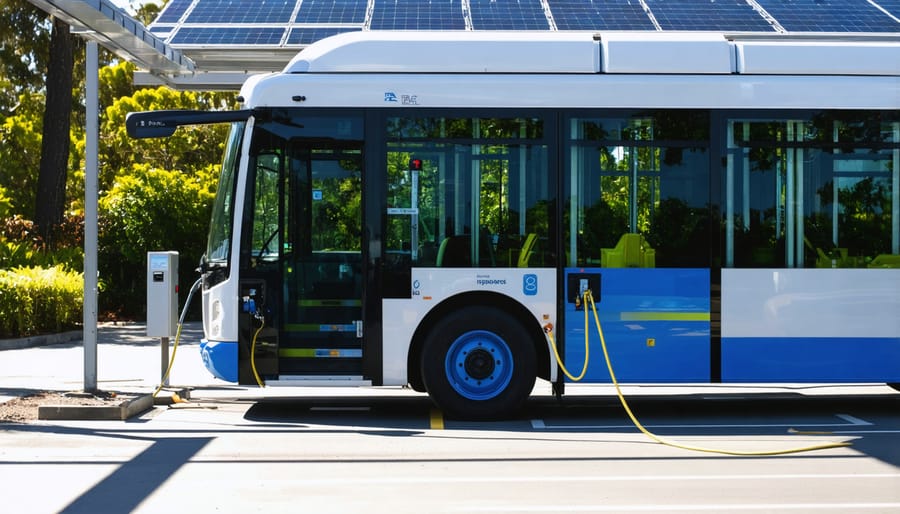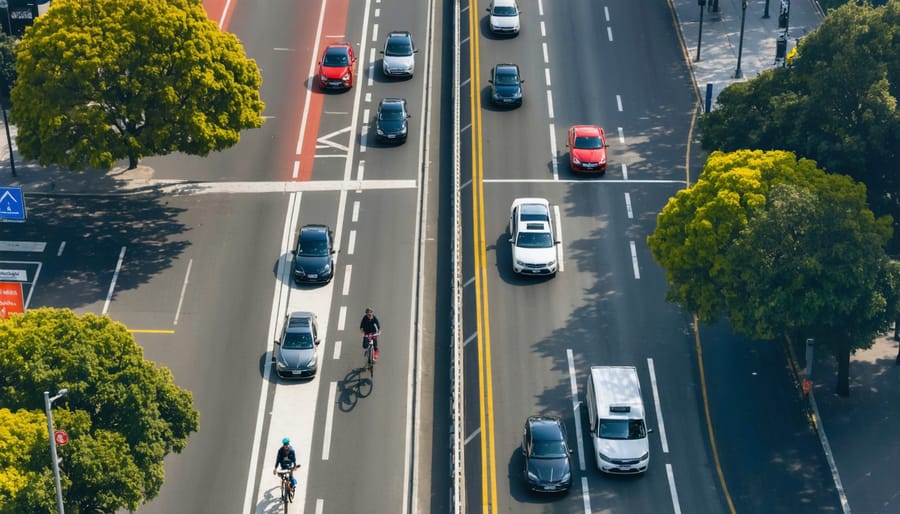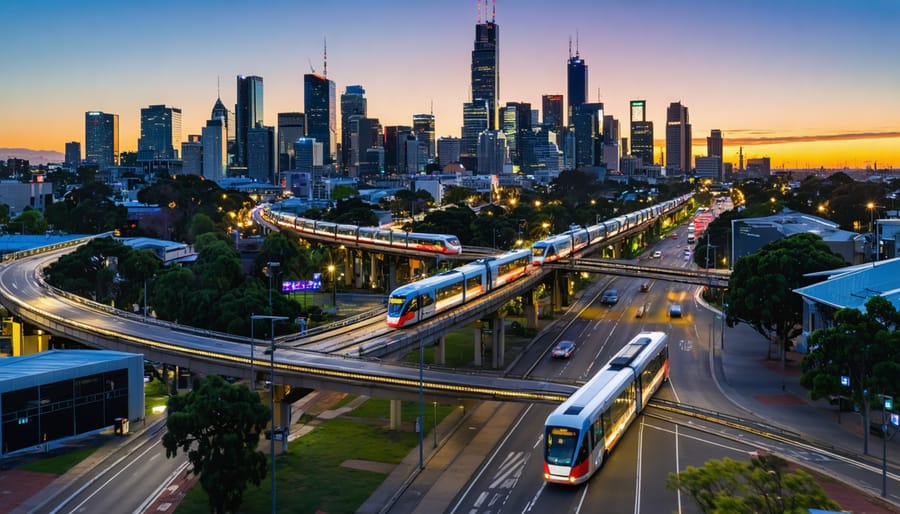Transform your city’s transport landscape with sustainable solutions that are reshaping communities across Australia and beyond. From electric buses silently cruising through Brisbane’s suburbs to Melbourne’s expansive bike-sharing network, sustainable transportation is no longer a future concept – it’s a present-day revolution driving environmental change.
Today’s most innovative cities are leading the charge with integrated transport systems that combine electric vehicles, renewable-powered public transit, and human-powered alternatives. These solutions not only slash carbon emissions but also create more liveable, connected communities while reducing transportation costs.
Whether you’re a city planner, business owner, or concerned citizen, understanding proven sustainable transport examples is crucial for making informed decisions about our mobility future. From award-winning projects in Perth’s solar-powered bus stations to Sydney’s electric ferry fleet, Australia is emerging as a global leader in green transportation innovation.
Let’s explore the most impactful sustainable transportation solutions that are already working in real communities, delivering measurable environmental benefits while improving the way people move through their cities.
Electric Public Transit: Leading the Green Revolution
E-Bus Success in Brisbane
Brisbane’s transition to electric buses stands as a shining example of sustainable transport innovation in Australia. In 2021, the city launched its ambitious zero-emissions bus program, starting with 16 electric buses operating from the Virginia depot. The initiative quickly proved its worth, with these vehicles collectively reducing carbon emissions by over 400 tonnes in their first year of operation.
The success of Brisbane’s e-bus program lies in its comprehensive approach. Transit authorities worked closely with local manufacturers to develop buses specifically suited to Brisbane’s climate and terrain. The vehicles feature advanced battery technology that allows them to operate for a full day’s service on a single charge, while smart charging infrastructure at depots ensures optimal energy usage during off-peak hours.
Passenger feedback has been overwhelmingly positive, with commuters praising the quieter, smoother ride and improved air quality at bus stops. Bus drivers report better working conditions, noting reduced fatigue due to decreased vibration and noise levels. The program’s success has led to an accelerated rollout plan, with Brisbane City Council committing to a fully electric bus fleet by 2030.
The economic benefits have also been significant. Despite higher initial investment costs, the e-buses have demonstrated 30% lower operating costs compared to diesel counterparts, with maintenance requirements notably reduced. This successful implementation has inspired several other Australian cities to follow Brisbane’s lead in sustainable public transport solutions.

Solar-Powered Trams in Melbourne
Melbourne’s tram network, the largest urban tram system in the world, made history in 2019 by becoming the first to be powered entirely by solar energy. This groundbreaking initiative demonstrates how traditional public transport can embrace renewable solutions while maintaining reliable service for millions of passengers annually.
The transition involved connecting the tram network to renewable energy microgrids and the Numurkah Solar Farm in northern Victoria, which generates about 255,000 megawatt-hours of clean electricity annually. This solar-powered system now offsets more than 80,000 tonnes of carbon emissions every year, equivalent to taking 17,000 cars off the road.
What makes Melbourne’s initiative particularly impressive is its seamless integration into the existing infrastructure. The system continues to operate with the same efficiency while significantly reducing its environmental impact. Passengers experience no difference in service quality, proving that sustainable solutions can be implemented without compromising performance.
The success of this project has inspired other cities worldwide to explore similar transitions. It showcases how major urban transport systems can effectively harness Australia’s abundant solar resources, setting a practical example for other metropolitan areas. The initiative also creates local jobs in the renewable energy sector while helping Victoria meet its renewable energy targets.
This transformation represents a perfect blend of heritage and innovation, proving that even century-old transport systems can lead the way in sustainable mobility solutions.
Biofuel-Powered Transport
Waste-to-Fuel Programs
Australia is leading the charge in innovative circular economy initiatives with waste-to-fuel programs that are transforming the transport sector. These groundbreaking projects convert organic waste from agriculture, food processing, and municipal sources into sustainable biofuels, offering a clever solution to both waste management and transport emissions.
In New South Wales, the Earthpower facility transforms food waste into biomethane, powering a fleet of waste collection trucks. This full-circle approach demonstrates how yesterday’s food scraps can fuel tomorrow’s transport needs. Meanwhile, Queensland’s sugar industry is setting a brilliant example by converting bagasse – sugarcane waste – into bioethanol, reducing dependence on fossil fuels.
Local councils across the country are jumping on board, with several metropolitan areas implementing organic waste collection programs specifically designed to produce transport-grade biofuel. These initiatives not only reduce landfill waste but also create locally-produced, renewable fuel sources.
The beauty of waste-to-fuel programs lies in their dual benefit: they tackle the growing waste management challenge while providing a sustainable alternative to traditional transport fuels. For fleet operators and transport companies, this represents a practical pathway to reduce their environmental footprint while participating in Australia’s renewable energy future.
Commercial Fleet Transitions
Leading Australian businesses are increasingly transitioning their commercial fleets to sustainable alternatives, setting inspiring examples for the industry. Woolworths Group has made significant strides by introducing biodiesel-powered delivery trucks across New South Wales, reducing their carbon emissions by up to 80% compared to conventional diesel vehicles. The supermarket giant’s initiative has already converted over 200 vehicles in their fleet to run on biodiesel derived from recycled cooking oil.
Australia Post has also embraced sustainable transport solutions, incorporating electric delivery vans and hybrid vehicles into their operations. Their successful pilot program in Melbourne demonstrated that electric vehicles could handle the demanding requirements of postal delivery while significantly reducing operational costs and environmental impact.
Linfox, one of Australia’s largest logistics companies, has implemented a comprehensive green fleet strategy, including biodiesel trucks and aerodynamic vehicle designs. Their commitment to sustainability has resulted in a 42% reduction in emissions per kilometre travelled since 2006.
These commercial transitions showcase how businesses can successfully integrate sustainable transport solutions while maintaining operational efficiency. Local councils across the country are following suit, with many municipal vehicle fleets now running on biodiesel or hybrid systems, proving that sustainable fleet management is both environmentally and economically viable.
Active Transport Infrastructure
Bicycle Superhighways
Bicycle superhighways represent one of the most innovative approaches to sustainable infrastructure development, transforming how cities approach urban mobility. Copenhagen’s Cycle Superhighway network stands as a shining example, featuring 45 kilometres of dedicated cycling routes that connect suburban areas to the city centre. These paths include green wave traffic signals, air pumps, and safe crossing points, enabling cyclists to maintain consistent speeds of 20km/h.
The Netherlands has taken this concept further with the RijnWaalpad, a 17-kilometre cycling highway linking Arnhem and Nijmegen. This state-of-the-art route features solar-powered lighting, heated surfaces for winter cycling, and wind-breaking barriers, demonstrating how thoughtful design can encourage year-round bicycle commuting.
Closer to home, Melbourne’s Strategic Cycling Corridors initiative is creating a comprehensive network of protected bike lanes and dedicated cycling routes. The St Kilda Road upgrade, in particular, showcases how Australian cities can implement European-style cycling infrastructure, featuring separated lanes and priority signalling for cyclists.
London’s Cycle Superhighways have transformed the city’s transport landscape, with routes like CS3 between Tower Gateway and Barking seeing a 75% increase in cycling traffic since its implementation. These successful examples prove that well-designed cycling infrastructure can significantly boost sustainable transport adoption while reducing urban congestion and emissions.

Pedestrian-First Zones
Across Australia and globally, pedestrian-first zones are revolutionising urban spaces and showcasing the powerful impact of prioritising people over vehicles. Melbourne’s Bourke Street Mall stands as a shining example of a successful car-free zone, where thousands of pedestrians daily enjoy a vibrant shopping and entertainment precinct without vehicle interference.
In Adelaide, Leigh Street and Peel Street have been transformed into thriving pedestrian zones, breathing new life into once-quiet areas. These zones now host bustling cafes, boutique shops, and community events, demonstrating how car-free spaces can boost local economies while reducing carbon emissions.
The success of these initiatives has inspired other Australian cities to follow suit. Brisbane’s Queen Street Mall, one of the country’s longest-running pedestrian zones, proves the long-term viability of car-free spaces in major metropolitan areas. These zones aren’t just about removing cars; they’re about creating liveable communities where people can walk, cycle, and interact safely.
International examples like Copenhagen’s Strøget and Barcelona’s superblocks have influenced Australian urban planners to think bigger. Many councils are now implementing “pocket parks” and “shared zones” where pedestrians have right of way, effectively creating a network of walkable communities connected by sustainable transport options.
These pedestrian-first initiatives are particularly effective when combined with efficient public transport links and cycling infrastructure, creating comprehensive sustainable transport networks that reduce dependency on private vehicles while enhancing community wellbeing.
Smart Mobility Solutions

Shared Mobility Services
Shared mobility services have revolutionized urban transportation in Australia, offering sustainable alternatives to private vehicle ownership. Bike-sharing programs have taken root in major cities, with Melbourne’s blue bikes and Brisbane’s CityCycle setting impressive examples of successful implementation. These initiatives not only reduce carbon emissions but also promote active lifestyles and help solve the “last mile” transportation challenge.
Sydney’s car-sharing success story demonstrates the growing appetite for sustainable transport solutions. With over 70,000 members across various car-sharing platforms, the city has seen a significant reduction in private car ownership. Each shared vehicle removes approximately 10 private cars from the road, leading to decreased parking pressure and reduced traffic congestion.
The GoGet program in particular has shown remarkable results, with vehicles strategically placed in residential areas, business districts, and near public transport hubs. Members can easily book cars for short trips using smartphone apps, paying only for the time they use. This model has proven especially popular among young professionals and families who occasionally need vehicle access without the burden of ownership.
Regional centers are also embracing shared mobility solutions. Newcastle’s innovative electric bike-sharing scheme combines sustainable transport with modern technology, featuring GPS-tracked bikes and solar-powered docking stations. These programs demonstrate how shared mobility services can effectively bridge the gap between public transport and private vehicle use while supporting Australia’s transition to sustainable transportation.
Transport Apps and Integration
The digital revolution has transformed how we access and use sustainable transport options, with innovative apps leading the charge in making eco-friendly travel more convenient than ever. These smart technology solutions are reshaping urban mobility across Australia.
Popular apps like TripGo and Moovit now feature carbon footprint calculators, allowing users to choose routes based on environmental impact rather than just time or cost. These platforms integrate multiple transport modes, from public transit to bike-sharing and electric vehicle charging stations, making sustainable choices more accessible.
In Sydney, the Opal app has evolved beyond simple fare payment to include real-time occupancy data, helping commuters make informed decisions about their travel times and reduce crowding. Melbourne’s PTV app similarly coordinates with bike-sharing services and provides walking routes, encouraging active transport options.
Transport for NSW’s Park&Ride app helps reduce inner-city congestion by guiding drivers to satellite parking facilities connected to public transport hubs. Meanwhile, innovative carpooling platforms like GoPool are gaining traction in regional areas, creating community-driven solutions for reducing single-occupancy vehicle trips.
These digital tools are particularly effective when integrated with existing transport infrastructure. For instance, Brisbane’s real-time bus tracking system works seamlessly with journey planning apps, making public transport more reliable and appealing to commuters who might otherwise drive.
The journey towards sustainable transportation in Australia represents a pivotal shift in how we approach mobility and environmental responsibility. Through innovative solutions and committed partnerships between government bodies, private enterprises, and communities, we’re witnessing a transformation in our transport landscape that promises a cleaner, more efficient future.
The examples showcased throughout this article demonstrate that sustainable transportation isn’t just an idealistic goal – it’s a practical reality delivering tangible benefits. From electric bus fleets in major cities to bicycle-sharing programs in regional areas, these initiatives are already reducing carbon emissions, improving air quality, and creating more liveable communities across the nation.
Looking ahead, the future of sustainable transport in Australia appears increasingly promising. Emerging technologies, including hydrogen-powered vehicles and smart traffic management systems, are set to further revolutionise how we move. The growing public support for green transportation solutions, coupled with decreasing costs of sustainable technologies, suggests we’re on the cusp of even more significant changes.
The success stories we’ve explored prove that sustainable transportation is not only environmentally beneficial but also economically viable. As more organisations and communities embrace these solutions, we can expect to see broader adoption of sustainable transport options, creating a ripple effect that extends beyond our shores and influences global transportation practices.
By continuing to invest in and support sustainable transportation initiatives, we’re building a legacy of environmental stewardship that future generations will inherit. The path forward is clear: sustainable transport is no longer just an alternative – it’s the way forward for a prosperous, clean, and connected Australia.

